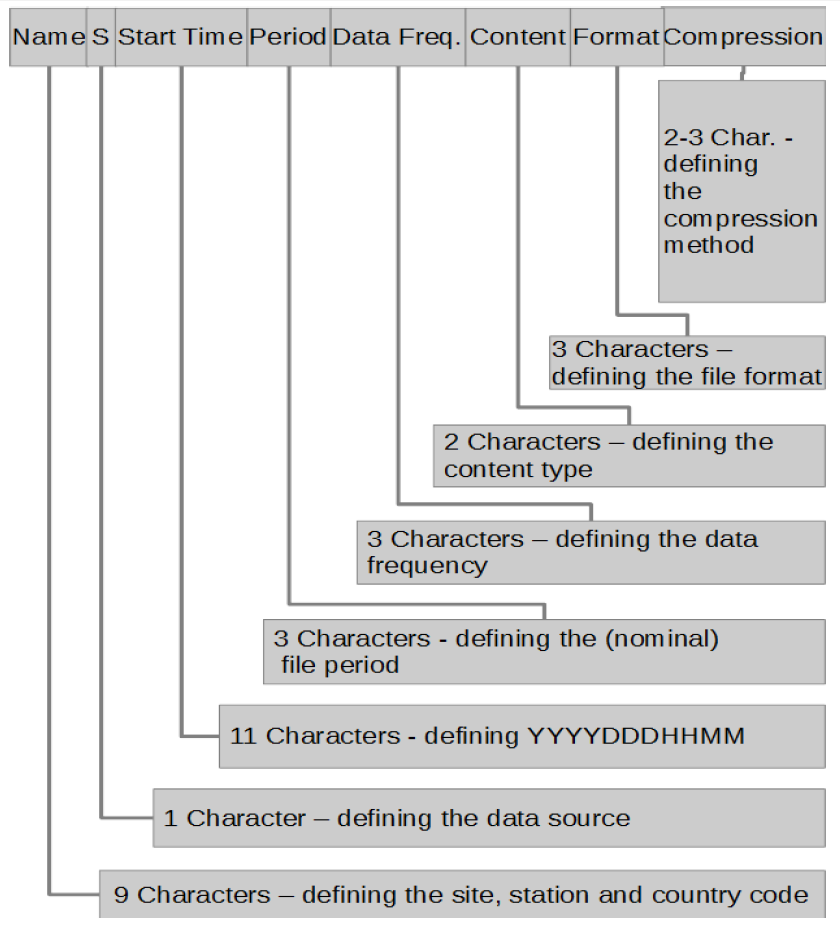Download PDF
Download page RINEX.
RINEX
The RINEX 4.x standard continues the use of descriptive and modern file naming, building on the conventions introduced in RINEX 3.x. File names are structured to be both human-readable and machine-parseable, accommodating all Global Navigation Satellite SystemsThe RINEX stands for (Receiver Independant EXchange Format) and is a standard ASCII file format used to store RAW GNSS observables. This file format allows Qinertia to process any type of GNSS receiver RAW data.
RINEX conventions
RINEX standard defines the file format as well as the file naming conventions to use. This is especially helpful to properly store and organize GNSS base stations RINEX data.
Over time, the RINEX standard has evolved through several versions, each introducing changes in structure and file naming:
This page provides only basic explanation about the different RINEX files and naming conventions. For detailed and authoritative information on the RINEX specifications, please visit the official IGS documentation: https://files.igs.org/pub/data/format/.
RINEX 3.x
The RINEX 3.x standard introduces a new naming convention that is relying on modern file systems. The new naming convention is more descriptive as the old MS-DOS limitation is not relevant anymore.
The following file convention is defined to store all GNSS data including observations and navigation data:

The following file name examples are extracted from the official RINEX 3.04 specification.
| File Name | Comments |
|---|---|
| ALGO00CAN_R_20121601000_01H_01S_MO.rnx | Mixed RINEX GNSS observation file containing 1 hour of data, with an observation every second |
| ALGO00CAN_R_20121601000_15M_01S_GO.rnx | GPS RINEX observation file containing 15 minutes of data, with an observation every second |
| ALGO00CAN_R_20121601000_01H_05Z_MO.rnx | Mixed RINEX GNSS observation file containing 1 hour of data, with 5 observations per second |
| ALGO00CAN_R_20121601000_01D_30S_GO.rnx | GPS RINEX observation file containing 1 day of data, with an observation every 30 seconds |
| ALGO00CAN_R_20121601000_01D_30S_MO.rnx | Mixed RINEX GNSS observation file containing 1 day of data, with an observation every 30 seconds |
| ALGO00CAN_R_20121600000_01D_GN.rnx | RINEX GPS navigation file, containing one day’s data |
| ALGO00CAN_R_20121600000_01D_RN.rnx | RINEX GLONASS navigation file, containing one day’s data |
| ALGO00CAN_R_20121600000_01D_MN.rnx | RINEX mixed navigation file, containing one day’s data |
RINEX 2.x
The 2.x standard defines a very simple naming convention and uses multiple files to store each type of measurements:
ssssdddf.yyt
| | | | |
| | | | +-- t: file type:
| | | | O: Observation file
| | | | N: GPS Navigation file
| | | | M: Meteorological data file
| | | | G: GLONASS Navigation file
| | | | L: Future Galileo Navigation file
| | | | H: Geostationary GPS payload nav mess file
| | | | B: Geo SBAS broadcast data file
| | | | (separate documentation)
| | | | C: Clock file (separate documentation)
| | | | S: Summary file (used e.g., by IGS, not a standard!)
| | | |
| | | +--- yy: two-digit year
| | |
| | +----- f: file sequence number/character within day
| | daily file: f = 0
| | hourly files:
| | f = a: 1st hour 00h-01h; f = b: 2nd hour 01h-02h; ...
| | f = x: 24th hour 23h-24h
| |
| +------- ddd: day of the year of first record
|
+----------- ssss: 4-character station name designator
RINEX Support
Qinertia can import RAW GNSS data from RINEX files to process rover and base station data. Both kinematic and static computations are supported. Qinertia support also compressed GZIP RINEX files as it can be found on several CORS providers.
Qinertia supports observations files at any rate up to 100 Hz for rover kinematic data and down to 30 seconds for base station data. Qinertia also handles automatically GNSS observations interpolation so you can safely compute a PPK solution using rover data at 20 Hz and base stations data at 30 seconds.
Last but not least, Qinertia is able to cope with GNSS observations that are not aligned to plain seconds even for kinematics computations. This feature is very unique and has to be implemented in the RTK engine itself. There is absolutely no way to align GNSS data during RINEX conversion as this will only work for static observations.
Qinertia supports the following RINEX versions:
| Version | Status | Remarks |
|---|---|---|
| 4.02 (2024) | PARTIAL SUPPORT | New signal types are parsed but not used |
| 4.01 (2023) | PARTIAL SUPPORT | New signal types are parsed but not used |
| 4.00 (2021) | PARTIAL SUPPORT | New signal types are parsed but not used |
| 3.05 (2020) | PARTIAL SUPPORT | New signal types are parsed but not used |
| 3.04 (2018) | PARTIAL SUPPORT | New signal types are parsed but not used |
| 3.03 (2015) | TESTED | |
| 3.02 (2013) | TESTED | |
| 3.01 (2009) | TESTED | |
| 3.00 (2007) | TESTED | |
| 2.11 (2007) | TESTED | Commonly used for based stations. |
| 2.10 (2002) | TESTED |
Native format vs RINEX
It's always better to use directly the GNSS manufacturer binary protocols as most RINEX converters tends to reduce accuracy and reliability. Qinertia supports natively several GNSS manufacturer file formats such as Septentrio, Ublox, Novatel and Trimble. Using native format both ease the post processing workflow but also avoids potential issues that could come from the RINEX conversion process.
RINEX Conversion
When you convert RAW GNSS data to RINEX, always try to disable all options that could modify the RAW GNSS data. For example, if you have a a GNSS receiver that outputs observations that are not aligned on the plain second such as u-blox F9 receivers, never ever use a RINEX converter tool to re-align the data to plain seconds!